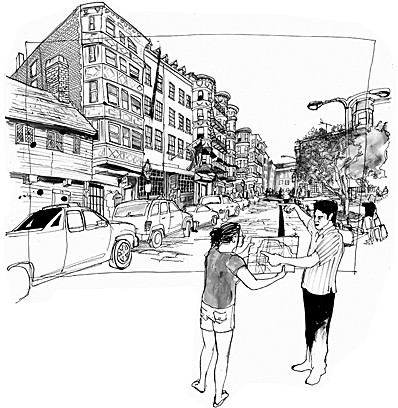
The first GPS
The lost art of giving directions
By Renée Loth | August 14, 2010
WHEN IT comes to the sense of direction, I am senseless. Some people are color-blind or tone-deaf; I am location-dumb; utterly lacking the internal compass that normal humans use to orient themselves in space.
I invariably turn the wrong way coming out of an elevator or stepping onto a busy street. I have gotten terrifyingly lost in a Tokyo train station, a Taiwan flea market, and somewhere in Somerville under the McGrath-O’Brien Highway. To commemorate a notable anniversary at work, my colleagues gave me a lovely printed scarf — and laughed when I realized the colorful pattern was really a map of Boston.
But this weakness has given me a special appreciation for people who know how to give good directions: detailed, clear, with obvious landmarks noted at strategic points along the way. I became a lifelong fan of the Lonely Planet travel guides 20 years ago on a solo trip to Hawaii, when I stopped along a scenic highway to look for a hidden waterfall and found the trailhead just where the guide said it would be, 200 yards past the chain-link fence after the mile-marker sign on the right. There is nothing like an accurate, lucid narrative to help fight insecurity and alienation — the very definition of being lost.
Trouble is, this skill is going the way of long division. Thanks to GPS,
In this season of vacation travel, I would like to issue a plea for a return to analog directions. This isn’t just a matter of technophobia. Writing good directions is not unlike poetry: an exercise in awareness, requiring an eye for detail and succinct but evocative language. It’s a delight to read something like “Travel over the old stone bridge — built in 1764! — until you see the brick library and Odd Fellows Hall on your right. Turn right there and go down the hill to the water.’’ Isn’t that so much better than “Head NW on S Main St/MA 1A N .5 miles toward Market Street,’’ or some similar digital version?
If you care enough and pay attention, you can learn a lot about people by the way they give directions. Are they nostalgic, mentioning phantom buildings or parks that were razed decades earlier? Are they crabbed and secretive, refusing to let you in on the shortcut? Landmarks give meaning to our surroundings, and everyone will emphasize a different place. One woman’s salt marsh is another man’s soccer field.
Unlike digital devices, written instructions on old-fashioned paper don’t fail during solar flares or send you a paragraph-long error message while you’re driving at 60 mph. They don’t use obscure references even the crustiest local has never heard, like “Lord’s Corner,’’ when everyone knows the landmark is the Dunkin’ Donuts. They don’t have dead spots.
Maybe digital positioning systems work OK in newer, grid-like spaces in the Midwest. But they collapse when confronted with the quirky byways of New England. We live on a street that passes from Boston to Newton with the same name, but the house numbers scramble when you cross the border. I can’t count the number of dinner guests or cab drivers who have called in frustration because they can’t find the address they have entered into their trusty GPS. Taking a few minutes to listen to verbal instructions would have saved them far more time in hapless circling.
Indeed, taking a few minutes to read good directions frees the traveler to enjoy the ride — to notice what the writer saw: the creeping fog over the harbor, or the golden haze on the cornfield. After all, the time spent in the car is also part of the vacation. It’s a chance to discover and savor new things. And for that, it’s a lot better than getting lost in Somerville.
Renée Loth’s column appears regularly in the Globe. ![]()